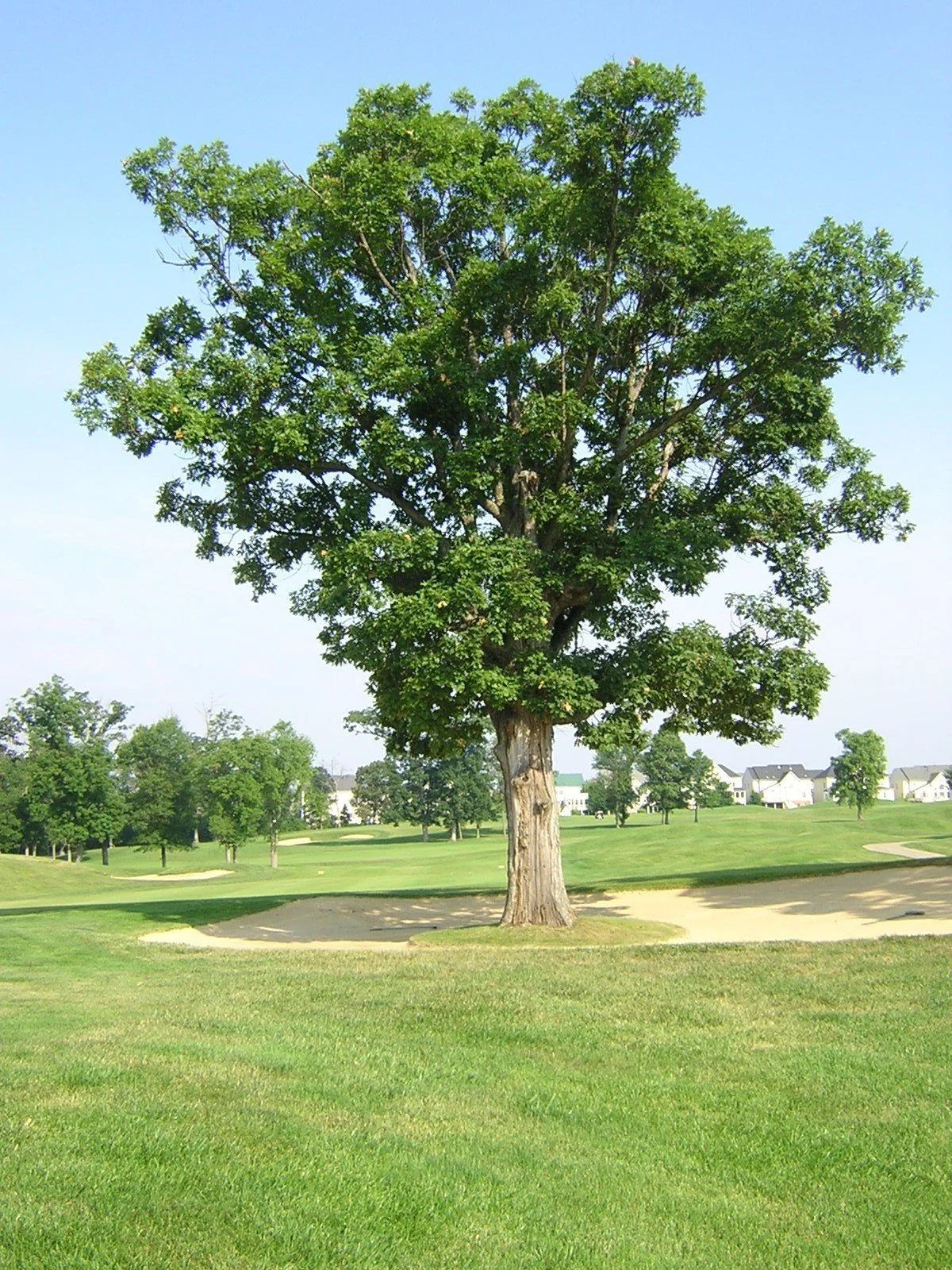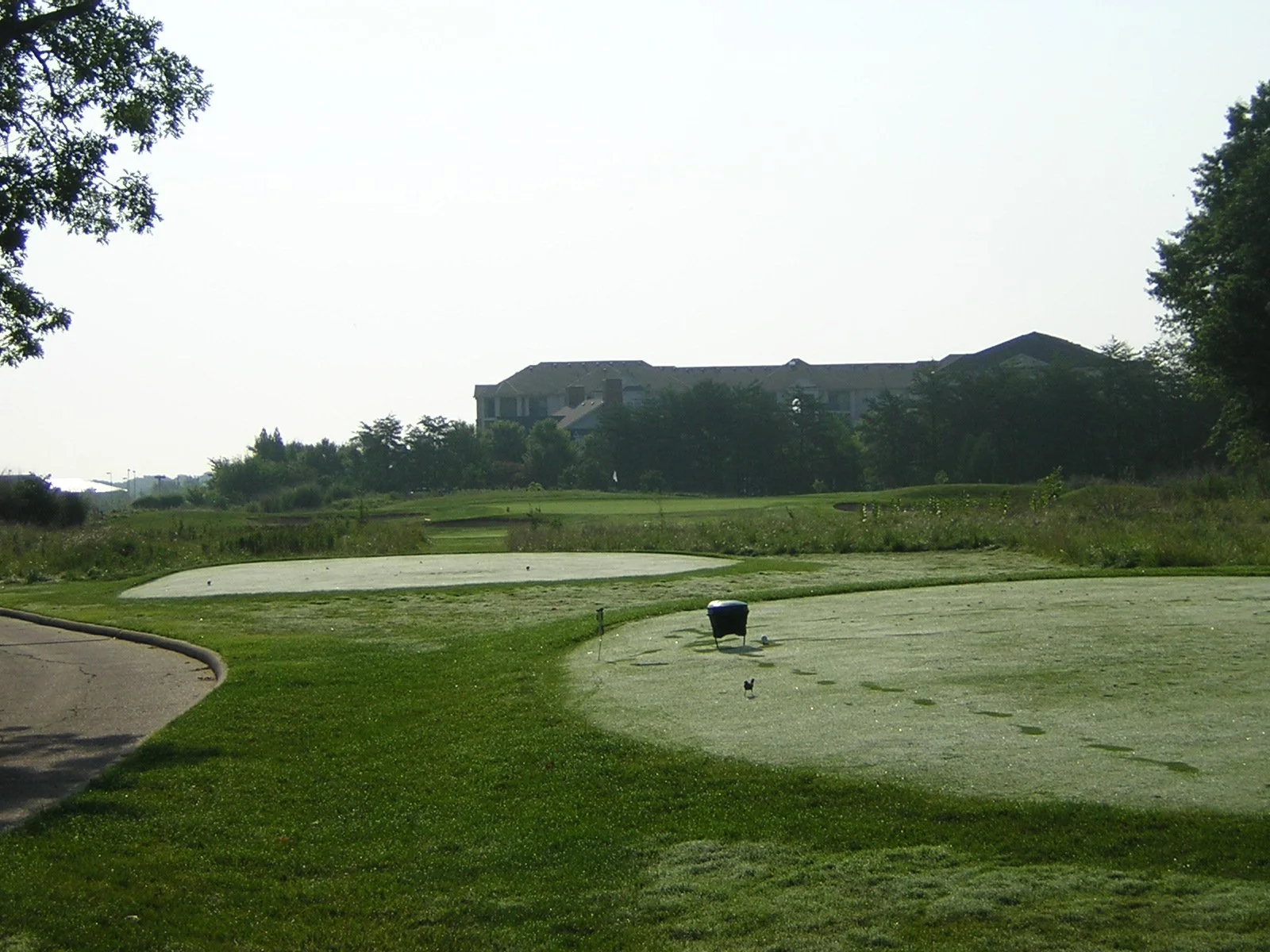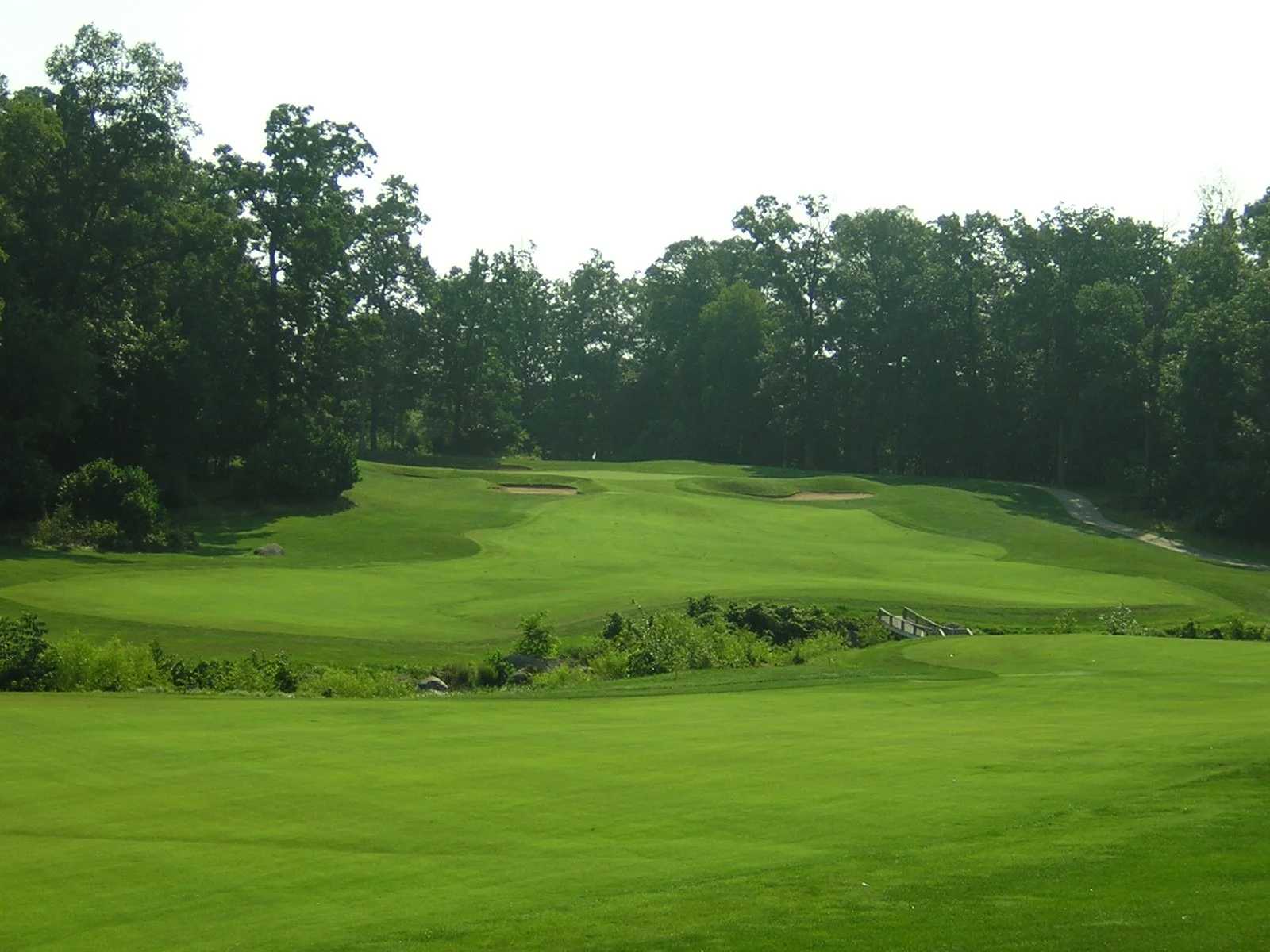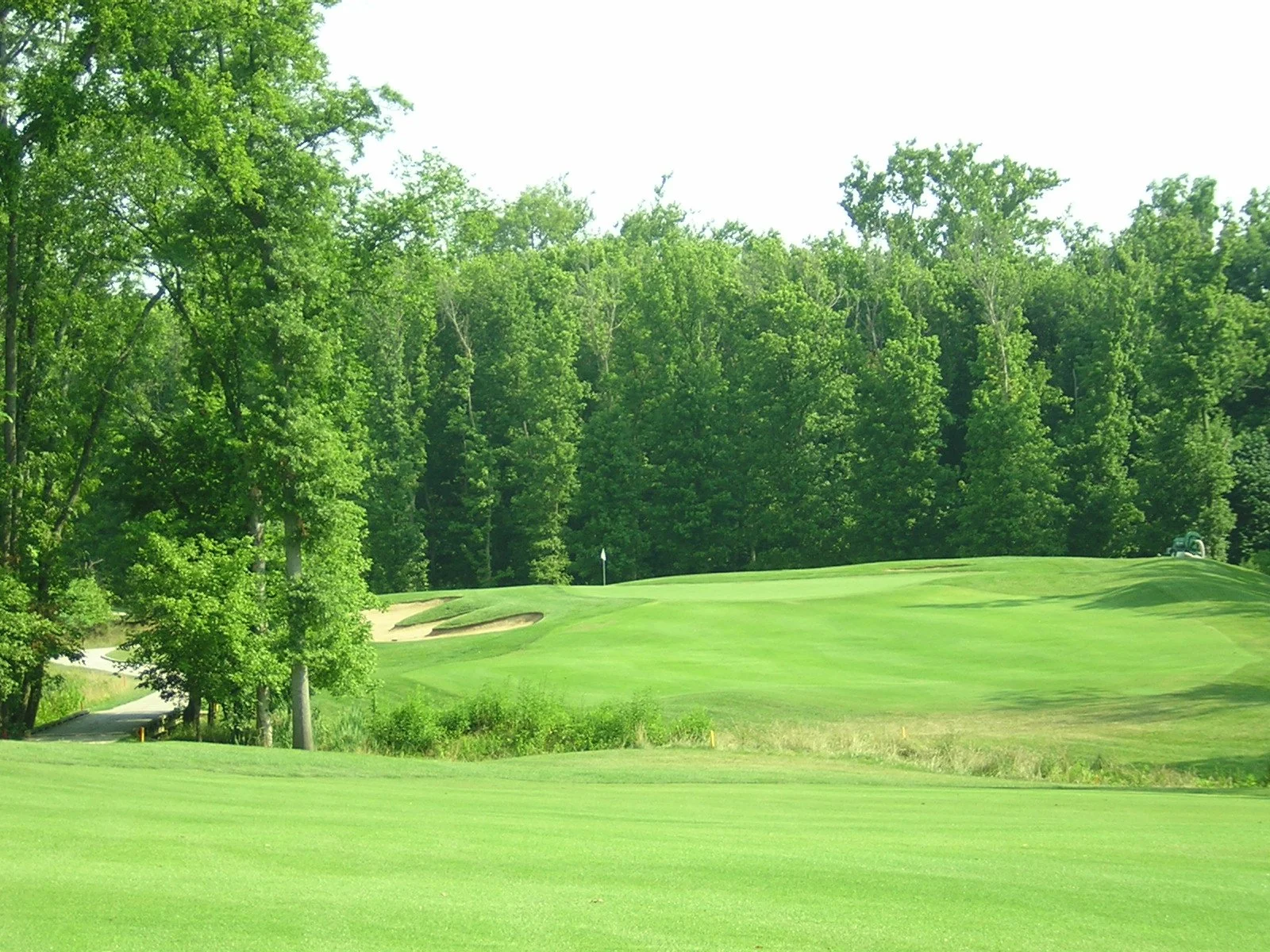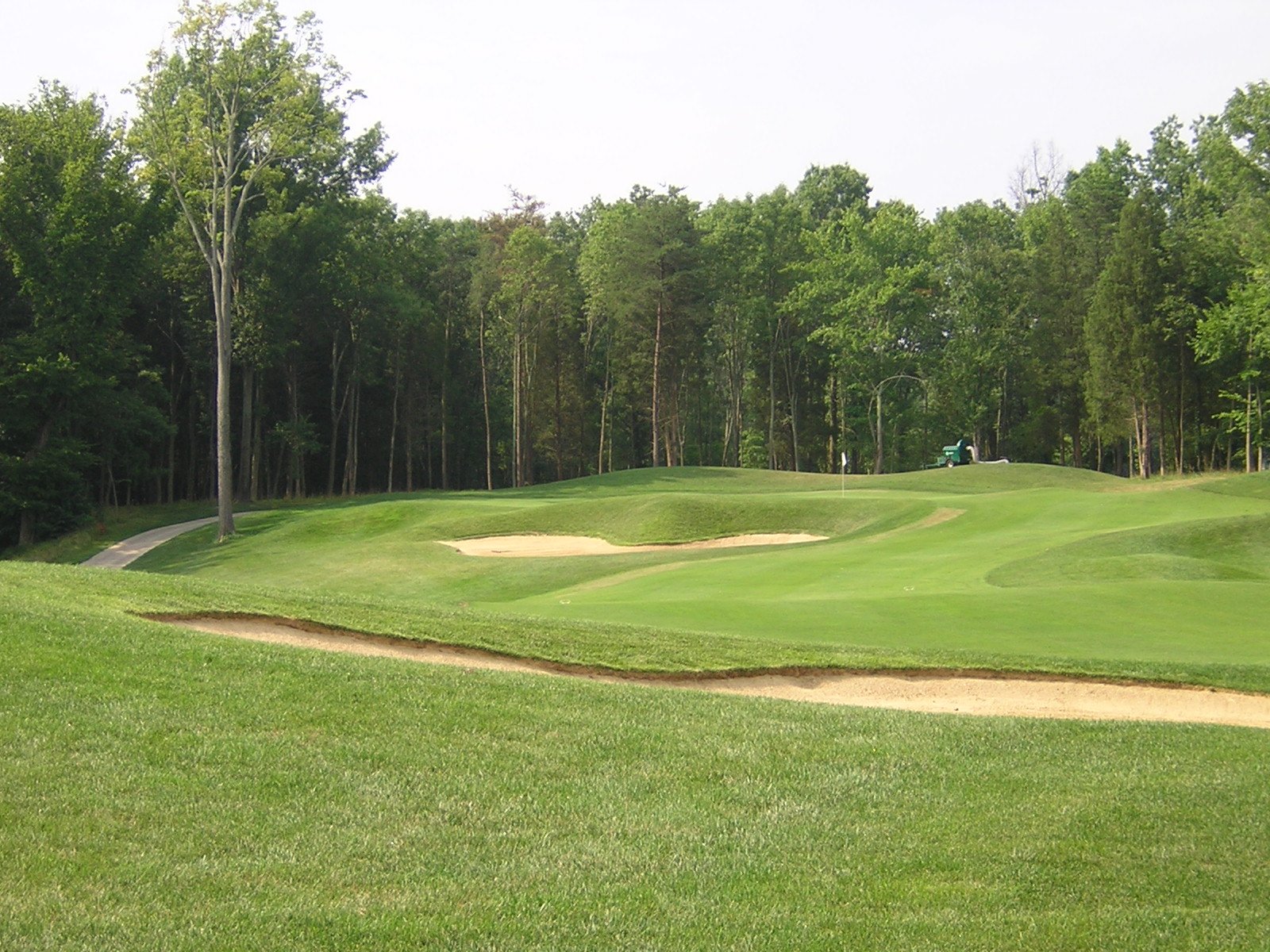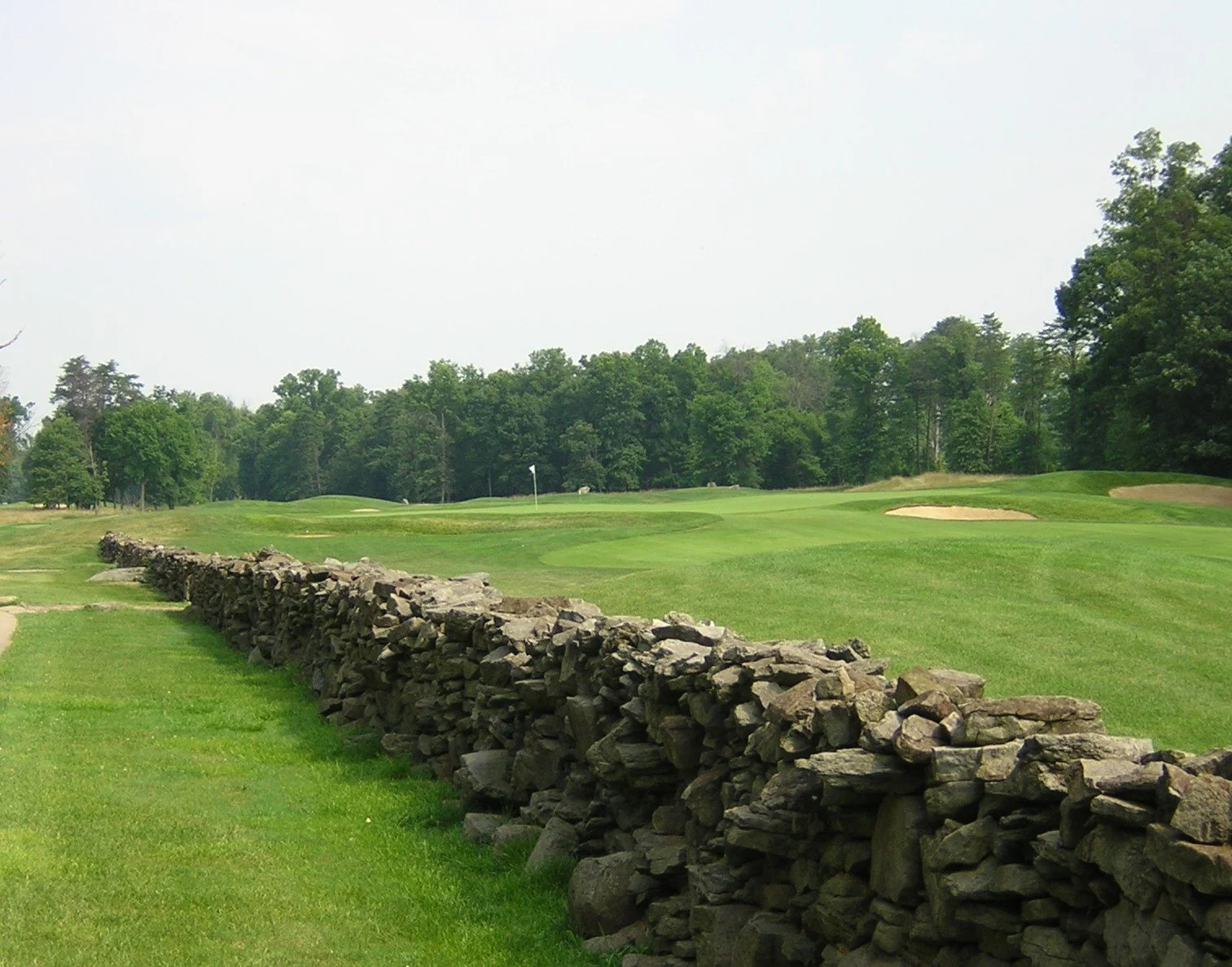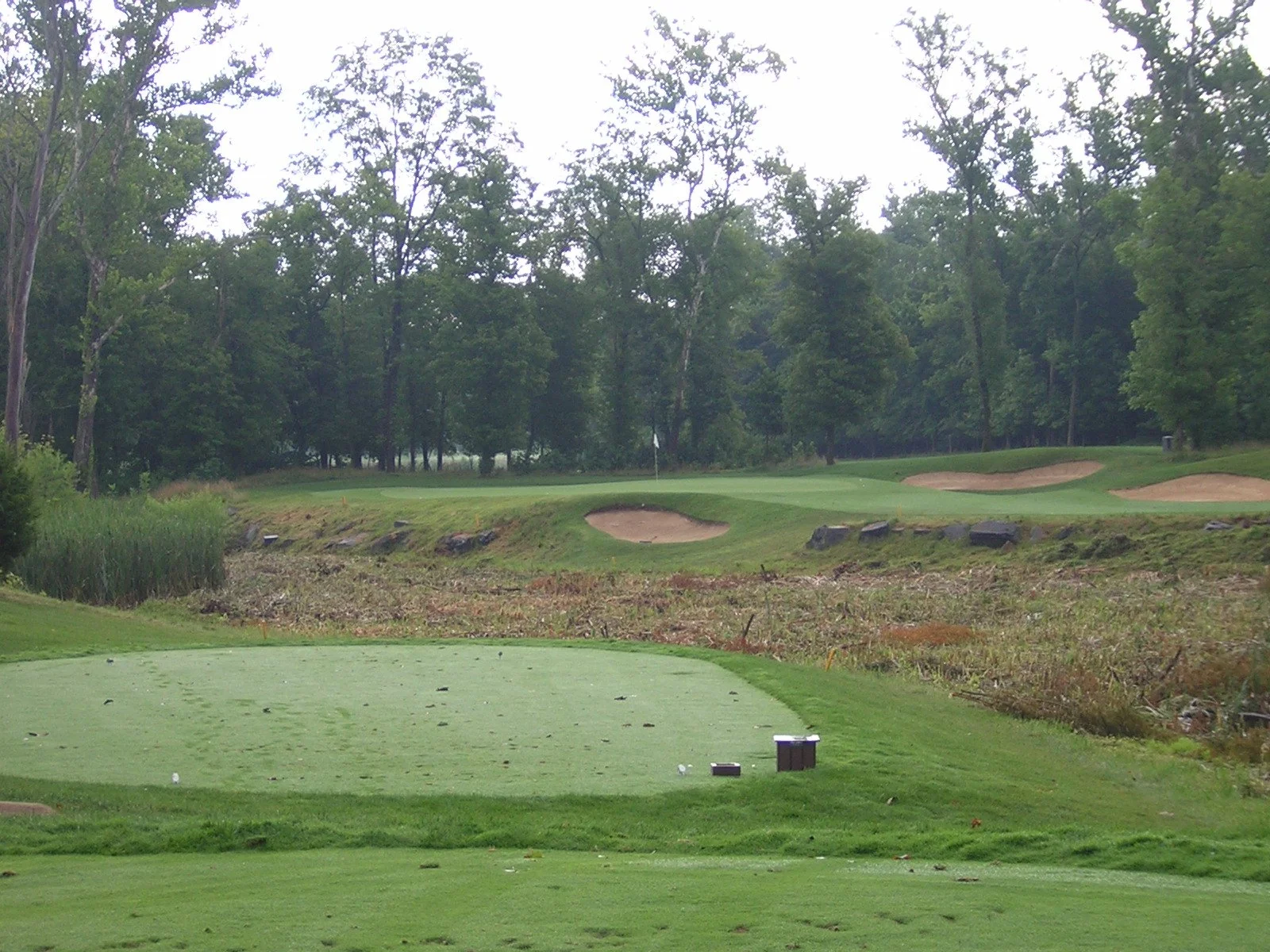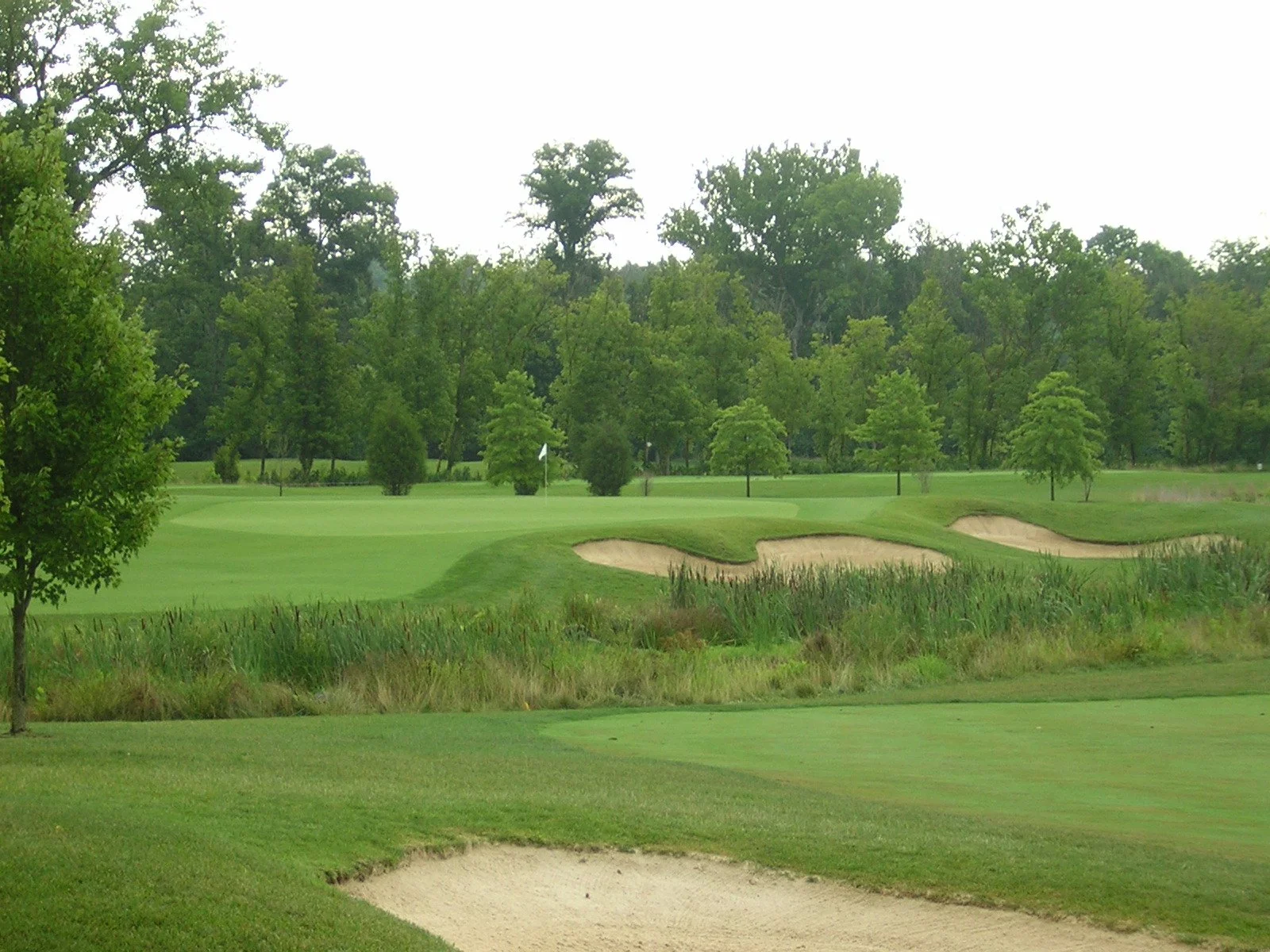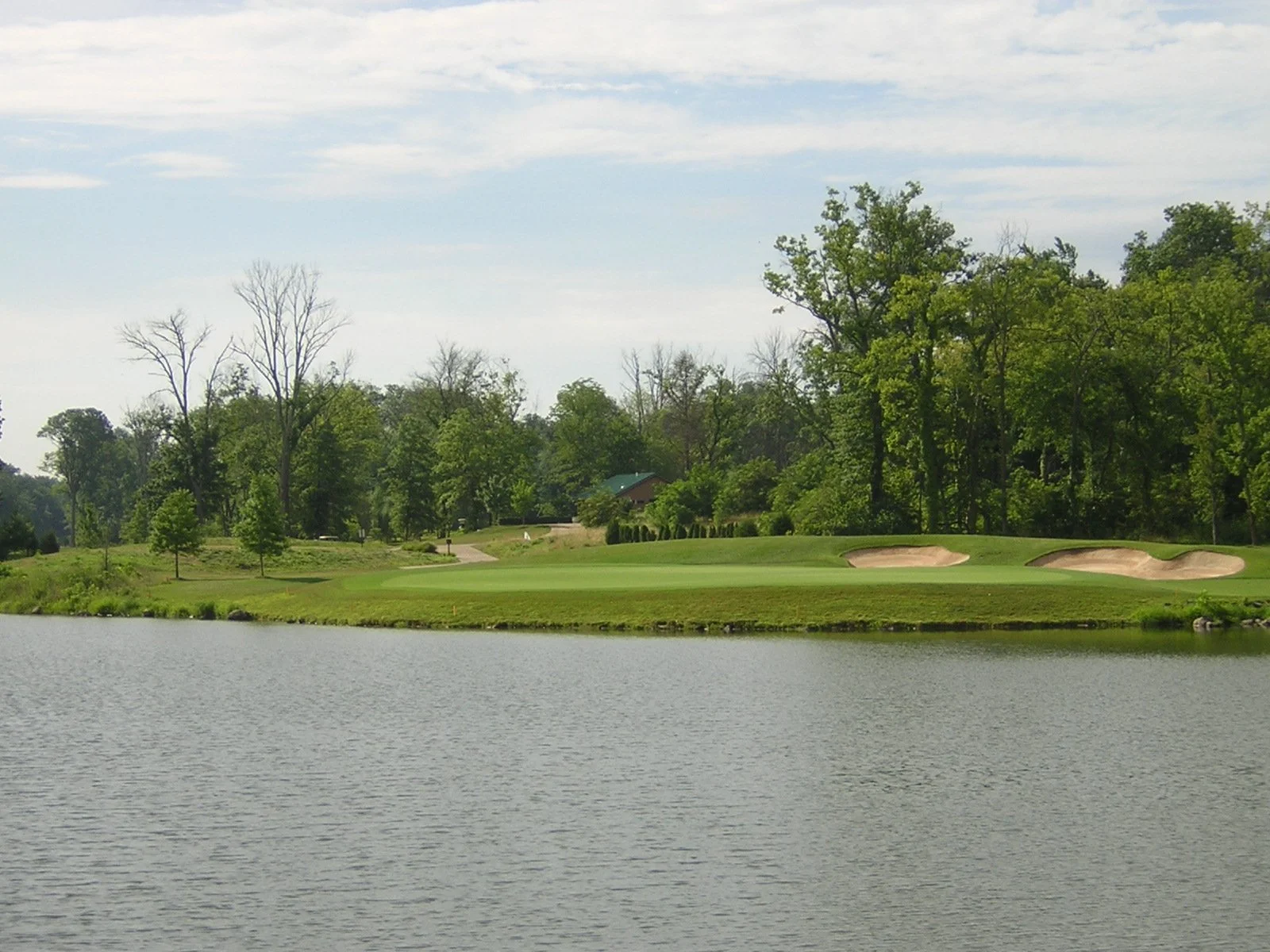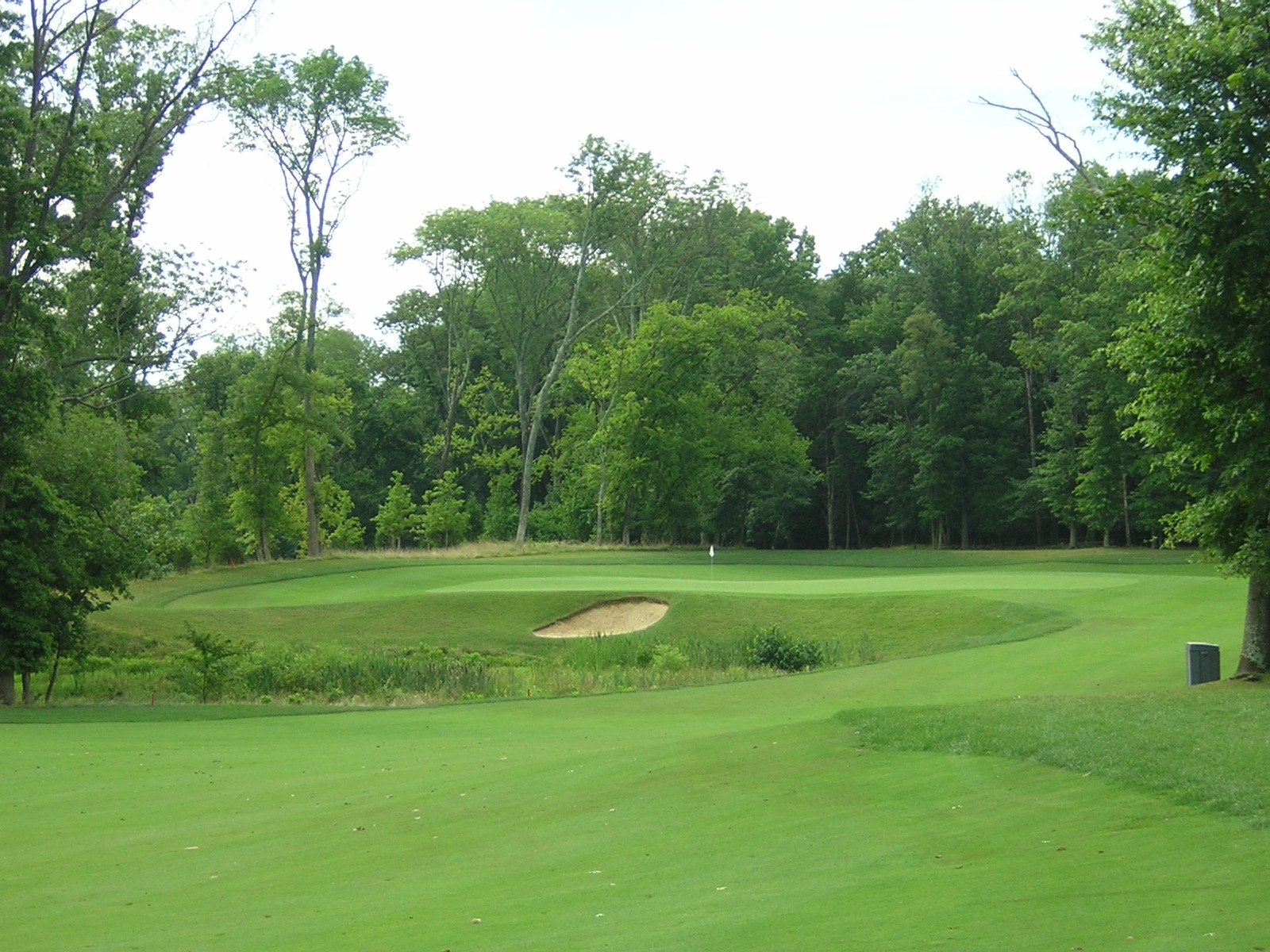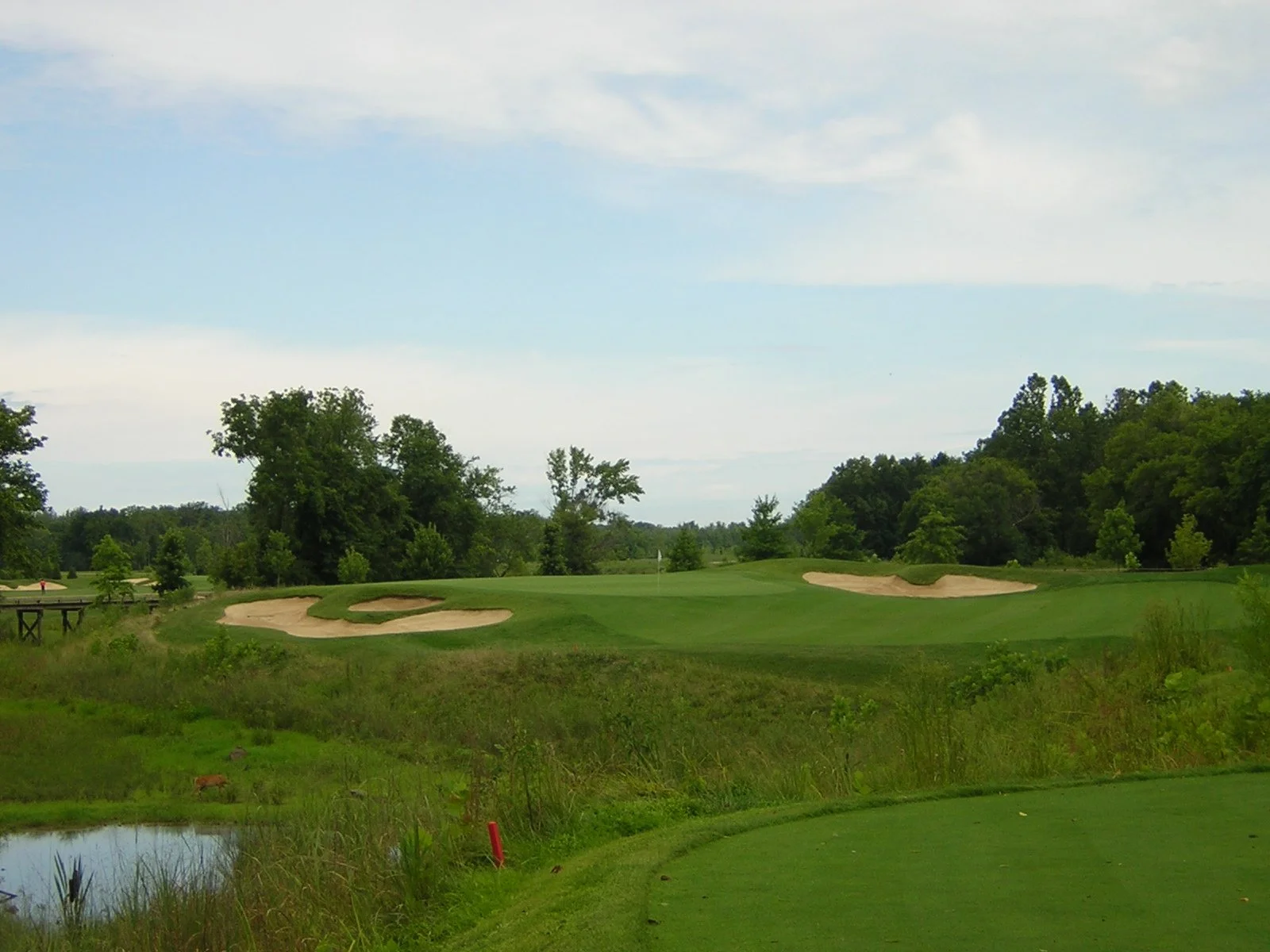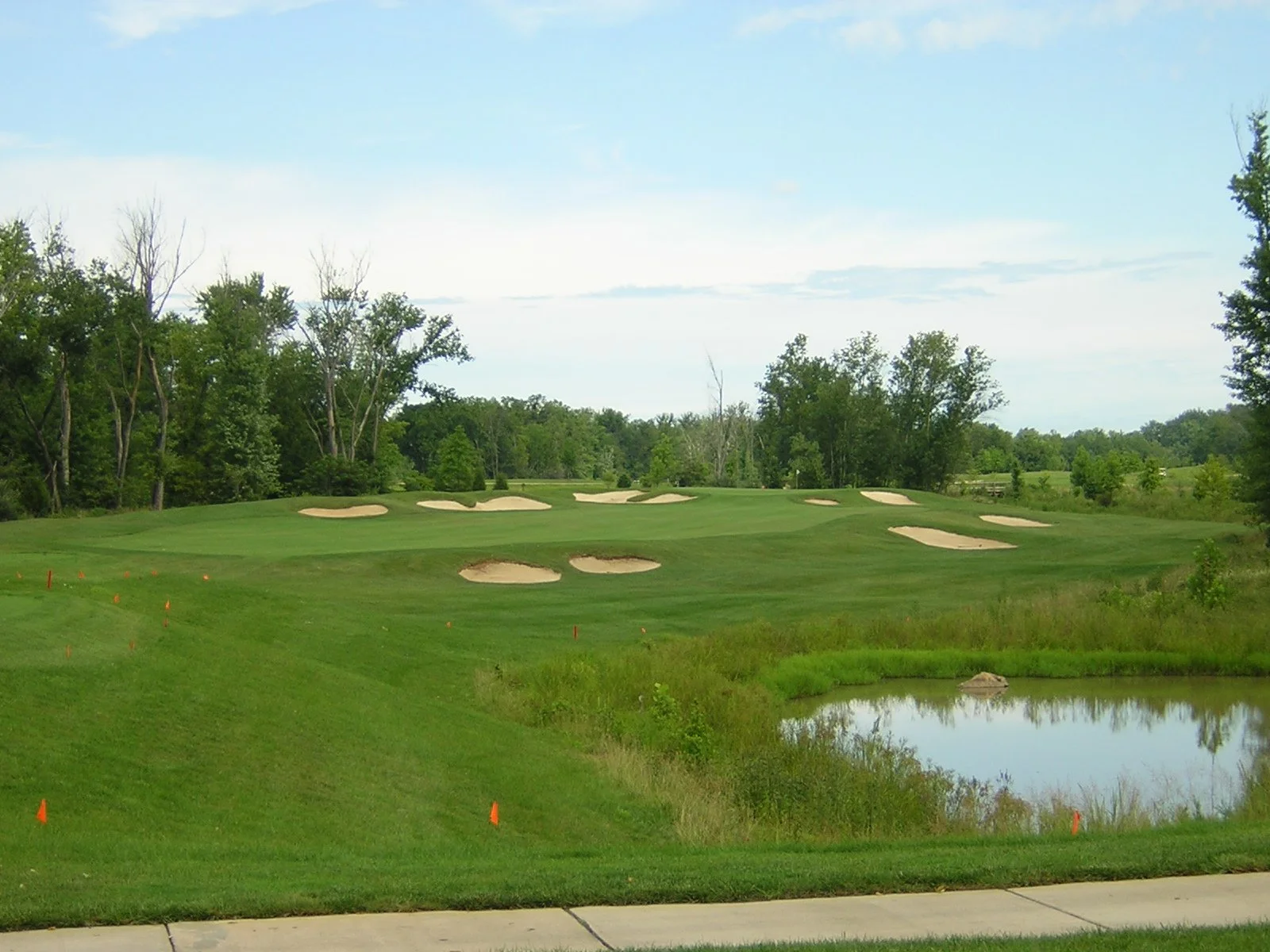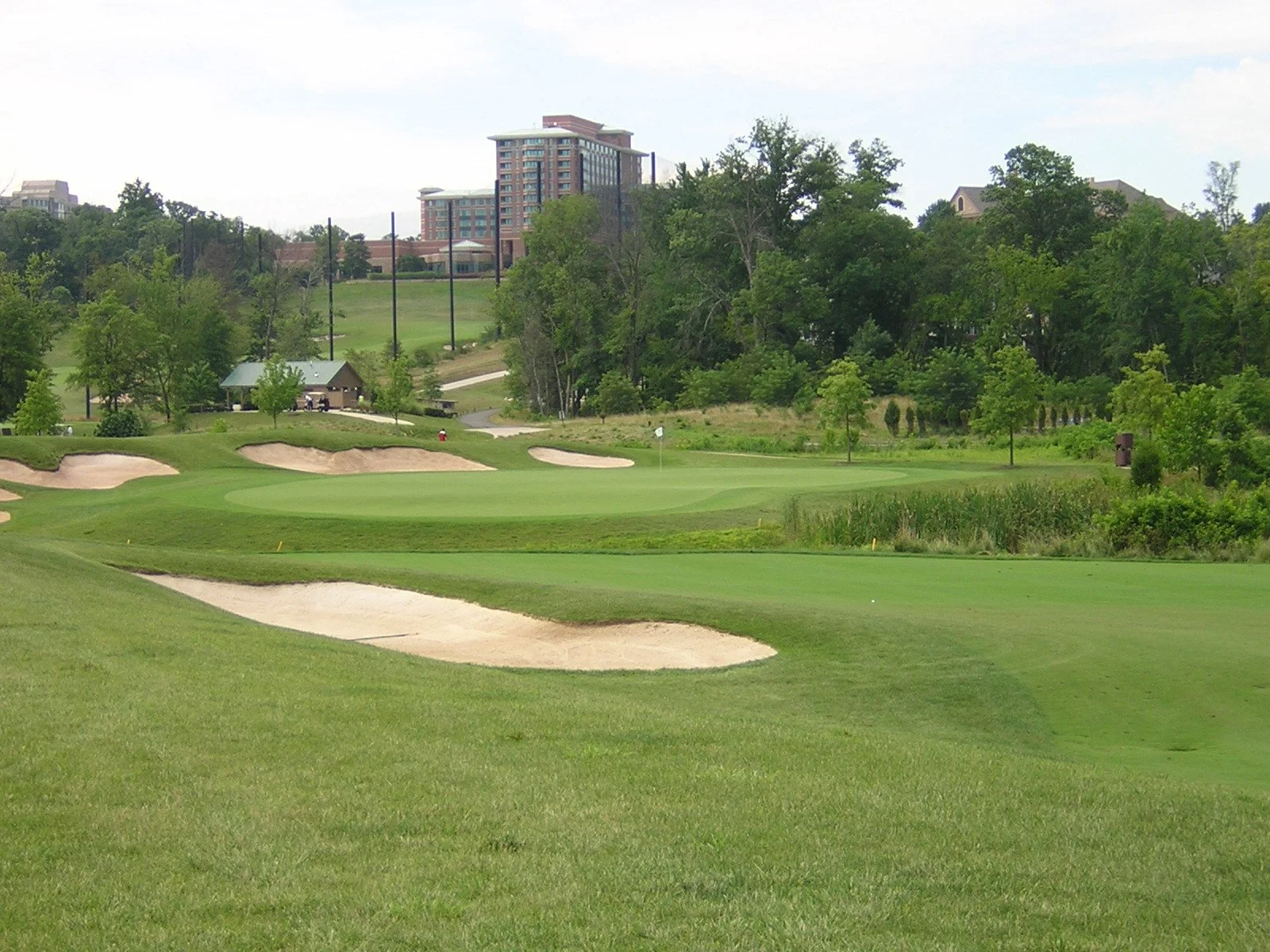THE GOLF CLUB AT LANSDOWNE
Jones Course Architect: Robert Trent Jones Jr (1991), Redesign (2003-04)
Year Opened: Summer, 1991
Location: Leesburg, Virginia
Slope: 142. Rating: 74.5
Par: 72
Yardage: 7,063
Hole-by-Hole: 1 - Par 4 368 Yds 10 - Par 4 379 Yds
2 - Par 4 397 Yds 11 - Par 5 580 Yds
3 - Par 4 353 Yds 12 - Par 4 441 Yds
4 - Par 3 225 Yds 13 - Par 3 210 Yds
5 - Par 5 610 Yds 14 - Par 4 409 Yds
6 - Par 4 442 Yds 15 - Par 4 391 Yds
7 - Par 3 177 Yds 16 - Par 5 533 Yds
8 - Par 5 504 Yds 17 - Par 3 203 Yds
9 - Par 4 424 Yds 18 - Par 4 417 Yds
Par 36 3,500 Yds Par 36 3,563 Yds
Key Events Held: Coast Guard Invitational (2009).
Awards Won: 4 stars by Golf Digest - Best Places to Play (2006-09),
Top-100 Golf Resorts in the World - Conde Nast Traveler,
Top-10 Courses in the Mid-Atlantic by Tee Time (1992), 2024 Smart Stars Award - Best Golf Resort from Smart Meetings Magazine.
Norman Course Architect: Greg Norman (2005), Chris Campbell (2017, bunker renovation)
Year Opened: September, 2005
Location: Leesburg, Virginia
Slope: 145. Rating: 75.5
Par: 72
Yardage: 7,332
Hole-by-Hole: 1 - Par 4 413 Yds 10 - Par 4 421 Yds
2 - Par 4 427 Yds 11 - Par 4 473 Yds
3 - Par 4 331 Yds 12 - Par 5 554 Yds
4 - Par 5 605 Yds 13 - Par 3 176 Yds
5 - Par 3 184 Yds 14 - Par 4 331 Yds
6 - Par 4 408 Yds 15 - Par 4 429 Yds
7 - Par 4 442 Yds 16 - Par 4 434 Yds
8 - Par 5 663 Yds 17 - Par 3 208 Yds
9 - Par 3 247 Yds 18 - Par 5 586 Yds
Par 36 3,720 Yds Par 36 3,612 Yds
Key Events Held: Coast Guard Invitational (2009).
Awards Won: AAA Four Diamond Resort (1991-present),
Top-100 Golf Resorts in the World - Conde Nast Traveler,
Top-10 New Courses You Can Play - Golf Magazine (2005), 2024 Best of DC Magazine - Best Drivable Destination - Modern Luxury DC.
Web site: www.lansdowneresort.com and www.golfatlandsdowne.com.
HISTORY: Since its early beginnings, Lansdowne Resort has been celebrated around the United States as a blue-ribbon meeting and conference facility, complete with exceptional amenities.
During the past decade, Lansdowne has also made a transformation into a world-class entertainment destination, not just a full-service conference center.
Originally owned by the Stone Financial Group when it opened its doors in 1991, Lansdowne Resort was sold to LaSalle Hotel Partners in 2003 for nearly $116 million. One year later, LaSalle began a renovation project that would bring the resort into the 21st century at an estimated cost of $45 million. Renovations and additions included a second golf course, a complete redesign of all guest rooms and public spaces, a multi-pool water complex, a 12,000 square-foot addition to the spa and a 40,000 square-foot clubhouse.
"While we are probably best known for our meeting services, the renovations and additional on-site recreation options will change this perception a bit," Gerard Dumont said. Dumont, the vice president and general manager for Benchmark Hospitality, which manages the property added, "We are expecting to broaden our appeal to even more leisure travelers looking for excellent quality and value in a charming historic region that offers cultural, educational and recreational options."
But let's not get ahead of ourselves. The original owners wanted to put Lansdowne on the map, not only as a conference center, but as an all-purpose resort. Tops on the list of development was a golf course and at the head of the class of architects were the usual suspects: Tom Fazio, Jack Nicklaus and of course the Jones family.
It's not easy to follow in the footsteps of one of the greatest golf course architects of all-time, but Robert Trent Jones, Jr. certainly has lived up to his legendary father's (Robert Trent Jones, Sr) reputation.
Over time, Jones II has crafted some wonderful layouts around the United States and throughout the world. Gems such as Chambers Bay (WA), Kaluhyat Golf Club (NY), Chateau Whistler Golf Club (Canada), the Prince Course at Princeville Resort (HI), Celtic Manor Resort (Wales), Le Meridien Moscow Country Club (Russia) and Southern Highlands (NV) to name a few.
After working with his father in the 1960s, Jones II embarked on a career that has now spanned over 40 years and more than 245 golf courses. One of his early designs was the first course at Lansdowne Resort.
The RTJII course opened in 1991 and was immediately named one of the top-10 courses in the Mid-Atlantic region. Continuously rated four stars by Golf Digest, the Jones layout features woodlands, fields, lakes, streams and natural stone outcroppings.
The Trent Jones II philosophy, which "calls for the creation of courses that combine playability for the average golfer with sufficient difficulty from championship tees to challenge the world's best players," is quite evident on this special venue.
Fourteen years later, Lansdowne Resort opened its doors to one of the most recognizable names in golf, Greg Norman to design a championship test. Norman, who won 88 times in his professional career, including two British Open titles, has designed more than 70 courses around the world. His resume' includes such sensational tracts as Doonbeg Golf Club (Ireland), Mission Hills Golf Club (China), Tiburon Golf Club (FL), TPC Sugarloaf (GA) and the National Moonah Course (Australia).
Opening in 2005, the Norman Course was named one of the Top 10 "Best New Courses You Can Play," by Golf Magazine. Norman has a simple, but elegant philosophy on his website. "I take seriously the legacy we create in designing and developing each golf course. It is this shared responsibility and process of building a relationship with the design client that gives me particular
satisfaction in creating golf courses that withstand the test of time."
Not a small task, but definitely accomplished at The Golf Club at Lansdowne.
REVIEW: JONES COURSE - The Jones course only has five par four's under 400 yards, three of which come in the first three holes. No., 1 is just 368 yards and played from an elevated tee. Bending slightly to the left and with a fairly attractive fairway, the first can be had. Take the driver and leave yourself just a wedge to a very receptive green. A large trap left must be avoided if you're to make par or better. The putting surface does run from back to front, so stay below the hole for your best shot at birdie.
The second hole can be a real bear, especially if you miss the fairway off the tee. Doglegging to the right, the landing area is expanded slightly, but trees flank the right and a large trap left can put doubt in your mind. Your approach, played to a slightly elevated green, must clear a crossing stream
and stay clear of the pond and out-of-bounds right. Not an easy task with the wind in your face. It comes as no surprise, that this hole earns the No. 1 handicap on the course.
In contrast, the third is the shortest par four on the course at just 353 yards, but it comes with plenty of difficulty. A sharp dogleg to the left, your tee shot must be precise, splitting the OB right and water left. The pond will again come into play with your approach, as it fronts the left portion of
the putting surface. Although you'll have a wedge in hand, the green is quite strategic, with a spine running down the middle and the slope of the surface bending towards the water.
The first par three on the course, is also the longest at 225 yards. To make matters worse, the green is narrow and long, guarded by sand right and deep. A back pin could add two clubs to your thought process and if the elements come into play, you might need three-metal off the tee.
If you think all par fives are reachable, guess again. The fifth is a robust 610 yards from the championship tees. Lock and load off the tee and again with your second and you'll have a reasonable short iron to a wide, two-tiered green. The fairway is wide at the onset, but your second will be played towards a tight landing area. Stay on your toes, or a big number might make your scorecard.
In my eyes, the Jones Course really heats up at No. 6. The longest par four on the course at 442 yards, this straightaway hole plays uphill towards the landing area. Deep bunkers down the left side are a no-no to have any chance of getting on in regulation. Making matters worse, the putting green, which slopes hard from back to front, is 40 paces long and narrow. If you can avoid the greenside bunker on the right, you can make par.
The seventh is the shortest par three on the Jones Course and the only one-shotter under 200 yards. Native grasses slightly obstruct the view of greenside bunkers left and right, so check your yardage book for positioning and green depth. The putting surface features a pair of tiers that can be
difficult to attack, so play towards the center of the green, two-putt and put a three in the books.
Finally a chance to get one back. The par-five eighth is ready for the taking. Just 504 yards, it's rated as the 17th easiest hole on the course. Don't let the yardage fool you however, as trouble lurks in the form of sand, sand and more sand. Bending to the right, your tee shot is the crucial play, as it must
avoid the myriad of bunkers down the right side, mostly hidden from view. This will leave a fairway metal or hybrid to a receptive green that plays slightly downhill. Miss the fronting bunker and you can make birdie, maybe even eagle.
Uphill all the way, the closing hole on the front nine is a solid par four of 424 yards and bending to the right. Cut the corner if you can over rough and sand and you'll be rewarded with a short- to mid-iron to a fairly large putting surface. Remember to add an extra club to reach the promised land. The wind will surely come into play, as the green sits atop the highest point at Lansdowne.
The closing nine opens with a wonderful, dogleg left par four. Just 379 yards long, the key on this downhill hole is the tee ball, which must find the fairway, avoiding the bunkers and rough left. Your second shot is played slightly uphill to the green, which is guarded by sand and a tall tree placed
strategically in the center of the left-hand trap. Miss long and your shot will end up well below the putting surface.
You'll need to lock and load when you reach the 11th tee, a whopping, 580-yard par five. The left side of the entire hole spells trouble, as a hazardous ravine lays in waiting. You're better off playing this one as a three-shotter, trusting your wedge game to get close for birdie. A deep bunker blocks the entrance to the green, so going for it in two makes little sense. The putting surface is slightly raised and the back and right of the green falls off sharply.
One of my favorite holes on the course is the 12th, a great dogleg left, uphill par four. The fairway is split into two separate areas by a stream, forcing the player with a major decision, go the short route left or play out towards the right. At 441 yards, the play is to the right, as this will leave an uphill approach with a mid-iron. Remember to take an extra stick to climb towards the green, as you must clear a bunker on either side of the front portion of the putting surface. Slanting hard from back to front, try and stay below the hole. I did and was able to make par.
If you thought that the last hole might have been the signature hole on the Jones Course, well you'd be mistaken. The downhill, par-three 13th features a 75-foot drop over a stone wall and a ravine, to one of the longest greens on the course. "Although 13 looks downhill, it actually plays the exact yardage," said former PGA Head Golf Professional and recently deceased Aaron Palen. "The course is a lot of local knowledge."
With redesign work done in 2004, the 14th is a wonderful, downhill, dogleg right par four, considered the second most difficult hole on the course. Your tee ball, from a chute of trees, must carry the winding creek to the undulating fairway. This will leave an uneven lie, over the creek to a green that tilts from right to left. A back-left pin can be quite difficult, with the huge bunker lurking close by.
Fifteen is slightly easier, but your tee ball needs to find the fairway. A large pond guards the right, while thick rough and the Potomac flank the left. Although just 391 yards, don't be deceived by the shortness of the hole, as your approach is uphill to a well-guarded green. A massive trap fronts the
green, so take enough stick, as long is a better play.
The par-five 16th is a great chance to make a birdie, as it reaches just 533 yards from the tournament markers. From the tee, the fairway looms large, but it tightens as you travel down the fairway. Several bunkers are placed down the landing area to keep you thinking about your approach to the green, not to mention the stone wall down the entire left side. Three bunkers protect the
entrance to the putting surface, but this hole can be had.
How often are par threes given a single-digit handicap on a course? Hardly ever, but the 17th is the sixth most difficult on the Jones course. The reason behind its ranking, the 200-yard carry over a pond, usually played into the wind. The putting surface is 35 paces wide, so make sure you hit the right section or a three-putt could creep into your stats.
The final hole on the course is no slouch, despite its modest 417-yard length. First of all, the hole doglegs sharply to the left with your approach playing straight uphill to a slick putting surface. There's plenty of room off the tee, but stay clear of the creek/ravine running down and up the left side. The 50-foot climb will necessitate an extra club or two to get home. Bunkers right and left are no place to be, but the thick grass beyond the green is just as bad.
NORMAN COURSE - With the switching of the nines, the Norman course now opens with a sensible par four of just 413 yards. The fairway is quite generous, but you'll need to favor the right side, avoiding the pond down the left side. From the back tee, you'll have to carry 230 yards across the water. Just a short iron should remain to a slightly elevated green that's 42 paces long and
slopes from back to front.
No. 2 features one of the widest fairways on the course, however the closer you get to the hole, the tighter the landing area gets. Play out towards the 150-yard marker and you're left with just a short iron to another long putting surface. Avoid the pot bunker left and judge your distance right and you could have a realistic birdie opportunity.
The third is a great risk-reward, drive-able par four. Just 331 yards from the tips, a player can really make his mark with a big blast in an effort to reach the putting surface. The fairway is very wide, so why not. The beautiful Potomac River will be in full view down the right, but will not come into
play, unless you're a nature lover and not a golfer. The green is 36 paces in length and narrow with sand left and right. The key here is your short game, so stay focused and birdie will be close at hand.
The first of two par fives over 600 yards on the opening nine, the fourth is played alongside the banks of Goose Creek. From the black markers, a drive of 240 yards is needed to carry a stream that starts the fairway of this long monster. Trees right and rough left will keep you on your toes as you traverse down the fairway. The putting surface, protected by a trio of traps in front, sits close to the Goose Creek's Clapham's Lock, built back in the 1800s for navigation through the historic channel. Getting back to business, you'll be hard-pressed to get home in two, but if you leave yourself in the short wedge area, a four is a definite possibility.
A natural wetland lurking close by on the left, makes the fifth a visually intimidating par three. Playing under 200 yards, this one-shotter features two large bunkers to the right in addition to a chipping area, a pot bunker short and the hazard left. To complicate matters, the green cants towards the left, so any shot just a shade off target will end up in trouble.
The second most difficult hole on the course, the sixth is a straightaway par four of just 408 yards. Originally the 15th hole, this four par started a four-hole stretch dubbed by Greg Norman as the "Hardest Mile in Golf," as they total 1,760 yards (exactly one mile). The tee shot is played to a fairly wide fairway, with one trap left and a lake right which is reachable off the tee. Your approach shot is played over wetlands to a slightly elevated putting surface which is just 33 yards in length. Two bunkers frame the front of the green and shaved chipping areas guard the left and rear.
No. 7 is a solid 442-yard par four, with water all along the right side. This classic Cape design, features four bunkers framing the left side of the fairway, dug into steep mounding. The fairway is generous, but the water right will surely get your attention. The putting surface is quite long at 42 paces with a runoff area to the left and the water snug to the right.
The longest hole on the course, the eighth is a whopping 663 yards. From the tips, you'll need to avoid the first fairway trap on the right, some 310 yards away. Tall Red Cedars protect the left side, but the fairway is generous, so lock and load. Your second shot must stay clear of the pair of bunkers on the right, around the 140-170 yard mark. This will set up a medium to short iron to a slightly elevated green, with a massive bunker left and a huge, sloped swale to the right. If you miss the putting surface right, you're almost better off in the pot bunker, as the swale is eight feet below the green.
The original closing hole was a beautiful par three. At 247 yards, it's all carry over a lake that fronts the entire green. The putting surface is 40 paces wide and 31 paces deep, with plenty of undulations. The two bunkers behind the green serve more as targets than obstacles, however the chipping area beyond the green makes for a difficult up and down.
The back side opens with four straight holes ranked as the top-10 toughest on the course. No. 10 is a 421-yard, dogleg left par four, with a creek and hazard running down the entire left side through the green. The fairway is generous, with just one bunker on the right, some 300 yards from the tee. A
good tee shot will leave just a mid-iron to a long and narrow, back to front running green. Two bunkers left sit below the surface, while a horseshoe bunker right is no picnic either.
One of my favorite holes on the course, the 11th is a robust, 473-yard par four. Avoid the tall tree down the right and bunkers on the left as the fairway narrows and you'll have a mid-iron to a very deceptive green. Your approach must carry over wetlands and a pot bunker that fronts the putting
surface. Just 23 paces in depth, the green is quite wide and elevated from the fairway. Take an extra stick just to be on the safe side. I made par, so can you.
I love risk-reward par five's, if that's what you call the 12th. It's 554 yards and plays uphill towards the green. A tee shot favoring the right side can set up an attempt to get home, but guess what, it's quite risky. Down the right is the Potomac River, just outside the reach of the cart path. The port
side features wetlands that creep ever-so close to the fairway, pinching the landing area at the 300-yard mark. Even with a successful tee ball, you'll have over 240 yards to an uphill target. Two deep bunkers front the green, although a chipping area lies between the sand and the promised land. Play
short with your second and you'll have just a wedge to an undulating green that possess a ridge from left to right. In my opinion, from the back tee, you're not getting home in two, so play smart.
A breather of sorts, the first par three on the back side is just 176 yards in length, the shortest hole on the course. But, hold on, it's uphill and features a massive, 7,000 square foot putting surface. The green is as sloped as any on the Norman Course, with sand left and right. Any shot short of the
putting surface will feed its way back down the chipping area, while long might end up wet, so choose wisely off the tee.
Finally, a hole that can be had! The short 14th is just 331 yards and features one of the widest fairways on the course. In the words of John Daly, "Grip it and Rip It." Sand in strategic places adorns the landscape, left and right, but it's the thick rough that will make you crazy if you stray offline. The minuscule putting surface is just 27 paces deep and slopes away from the player in the rear, where another tightly mown chipping area awaits. Oh, you can make birdie, but bogey can sneak up on you if you're not careful.
The 15th is a wonderful, dogleg left par four. A wide fairway awaits, but beware the rough and wetlands left or you'll be scrambling to make double. At 429 yards, a mid-iron should suffice to a very accessible green. As usual, a collection area stands guard left, so precision is a must. Miss right and you're in big trouble. I'm still looking for my ball.
Formerly No. 7, the 16th is far from lucky. At 434 yards, water right and wetlands left, it comes as no surprise that it's the No. 1 handicap hole on the course. Despite the wide fairway, the landing area slopes towards the left and the trouble. The right side of the fairway is the best, but tall trees and
the river guard that avenue. The putting surface is long, with a chipping area right and wetlands, up close and personal on the left. A back-left pin is dangerous, so be cautious.
Rated the 17th easiest hole on the course, the second-to-last hole is anything but. At 208 yards, it features one of the longest greens at 48 steps. It is quite narrow and undulating and with a back pin, you might need three-metal. Three pot bunkers left can save a misguided approach where water lays in waiting. The deep trap right will make for a difficult par-save. The best course of action, play short-right of the green, chip up and make your par. If I would only take my own advice.
The closing hole on the Norman Course is another long par five, this time stretching 586 yards from the black buttons. Moving hard to the right, you need to avoid the 30-yard trap on the left corner. This will set up a layup to a tight, landing area. A pair of traps on the left and wetlands right squeeze
the layup zone. Your approach must carry the wetlands to the green, but with a short iron, it should not be an issue. The kidney-shaped putting surface features three tiers and a handful of bunkers beyond the collection area. If I can make birdie, anyone can.
FINAL WORD: Most people talk about resort courses as being very player-friendly, with wide fairways, slower greens, little rough and minimal trouble. If that's the case, then most people have not ventured to Lansdowne Resort.
This wonderful retreat boasts 36 holes of championship golf, and I mean championship golf. Not to mention a nine-hole layout called "Sharkbite," which we'll discuss later.
But that's just the tip of the iceberg. Let's start at the top.
Lansdowne is located just 25 miles from the nation's capital and only eight miles from Washington Dulles International Airport. That means, this wonderful haven of fun and relaxation is within an hour from Baltimore three hours from Philadelphia and Richmond, and yes, a simple plane ride from anywhere else on the east coast.
The resort itself, a AAA Four Diamond Award winner, features 305 well-appointed rooms and suites, overlooking the Potomac River and the golf courses. In addition, this nine-story tower offers beautiful views of the nearby Blue Ridge mountains.
With over 45,000 square feet of conference space, Lansdowne is the ideal destination for a corporate retreat, no matter the size. Complete with your own conference concierge, you may select one of the 25 dedicated meeting rooms or the amazing, state-of-the-art audio-visual, 126-seat tiered Amphitheater.
If dining is your shtick, then go no further than the wonderful culinary choices at On the Potomac, The Riverside Hearth or The Crooked Billet. All three provide wonderful dining options to satisfy even the pickiest of palates. For me, it was the sensational Sunday Brunch. From Eggs Benedict,
made-to-order omelets and malted waffles, to carved rack of lamb, chicken, duck, trout, you name it. How about a seafood and raw bar? Or an Antipasto station? Of course, soup and salads and the piece de resistance, the dessert section. You only live once, so watch your weight another week.
But there's more...Spa Minerale. A full service spa and health club is the latest luxury afforded to the guests and members of Lansdowne Resort, from hot stone massages to facials, pedicures, manicures, hair treatments and the latest in body treatments. Best of all, it's not just for the ladies anymore.
Guys, delve into this wonderful experience.
Kids, I have just the ticket for you. How about a water complex, complete with five pools, an interactive pop jet fountain and poolside food and drink service. But what aquatic destination would be complete without a waterslide? Trust me when I say, your children will spend hours taking turns cruising down the slide. For the parents, Lansdowne even offers an adults-only section, not to mention an indoor lap pool.
If you're still bored, how about some tennis, racquetball, volleyball, fitness classes, personal training, hiking and biking.
Still not convinced? Let's talk golf.
The Robert Trent Jones, Jr. layout can play from as little as 5,165 yards to a solid 7,063 yards from the tournament tees. Ladies will enjoy this tract and the guys will embrace the course from start to finish. "RTJ is more user friendly off the tee box, however, it is a very difficult golf course in its
own right," commented Palen. "The rough and the contours of the greens make it a very hard golf course to make a par on."
Although the RTJ II course uses the natural beauty of the land, featuring natural stone outcroppings, rock walls, woodlands and fields, it certainly is no pushover, as its 74.7 rating indicates. "Once you get to the back nine, it's probably the hardest nine on the property out of our 45 holes," added
Palen.
A low country experience, the Norman course is the masterpiece of Lansdowne. 7,332 yards and a slope of 75.8 from the black tees, this layout can rip your heart out. Don't be discouraged, there are five sets of markers beginning at 5,371 yards, so even the higher handicapper can enjoy this architectural marvel. "When Norman was built, the whole idea was to hold a Tour event,"
continued Palen. "The layout of the Norman is the best in Northern Virginia."
Built alongside the Potomac River, the Norman course is incorporated into the land, not contrived like some courses built this decade. Rolling terrain, hardwood forests and the natural elements are what this course is all about. "The course sits in the wetlands and is built on a flood plain, and it floods frequently in the spring, but it is designed to withstand the flooding," continued Palen. "All the tee boxes and greens are raised. So, if you're a smidgen off your tee shots and approaches, you're penalized severely."
In addition, Norman created a nine-hole layout designed with the family in mind, the Sharkbite course. A wonderful venue in which to practice, Sharkbite is fun to walk and enjoy with the entire clan. "It's a great golf course for families and to practice on," mentioned Palen. "It is not an executive or par 3 golf course. It's a scaled down version of the big course." From as little as 870 yards, perfect for the juniors to 2,319 yards, the Sharkbite is a blast. "It's a fun golf course that offers a lot of variety. We get over 5,000 rounds per year, and it's always in excellent shape."
If it's a workout you want, then go no further than the 16-acre practice facility. Multiple grass hitting stations, three large putting greens and a short-game area to work on every facet of your game.
To play golf at Lansdowne, one must be a member or guest of the resort. A slight drawback, but with their affordable and creative Stay and Play packages for all parts of the resort, anything is possible. It's certainly worth looking into a membership. "We have 400 golfing members and our goal is to reach 700," said Palen. "In addition we have 85 social members. It's a great membership. Very young and very tech-savvy."
If for some strange reason, you decide to venture away from the property, you'll be more than satisfied with the history, museums, shopping and wineries nearby.
But for those of us who enjoy luxury and relaxation, Lansdowne Resort is the all-season destination.

